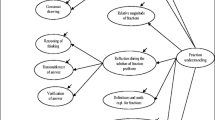Abstract
Fourth graders with differing achievement records participated in a specially designed two week unit on decimal fractions. Students were encouraged to connect meaningful referents with decimal fraction symbols and use these meanings to develop procedures for adding and subtracting decimal numbers. One year later these students and a matched set of fifth graders were interviewed and given paper-and-pencil tests. Three questions were of interest: (1) Do short term changes in the processes students use to solve problems remain stable over time; (2) Do students who have been instructed in conceptually-based processes exhibit a higher level of performance one year later than their conventionally taught peers; and (3) What is the relationship between entry achievement level and the year-long effects of conceptually-based instruction? The results suggest that: (1) If students used the meanings of written symbols as a basis for solving problems immediately after instruction, they used these processes to solve problems one year later, regardless of entering achievement; (2) Compared to their conventionally taught peers, students in the lower achievement group benefitted relatively more from the conceptually-based instruction than students in the higher achievement group; (3) However, higher achieving students were more likely to exhibit use of conceptually-oriented processes one year later than the lower achieving students.
Similar content being viewed by others
References
AuK. H. and KawakamiA. J.: 1984, ‘Vygotskian perspectives on discussion processes,’ in P. L.Peterson, L. C.Wilkinson, and M.Hallinan (eds.), The Social Context of Instruction, Academic, Orlando, FL, pp. 209–225.
BehrM. J., WachsmuthI., PostT. R., and LeshR.: 1984, ‘Order and equivalence of rational numbers: A clinical teaching experiment,’ Journal for Research in Mathematics Education 15, 323–341.
BellA., SwanM., and TaylorG.: 1981, ‘Choice of operation in verbal problems with decimal numbers,’ Educational Studies in Mathematics 12, 399–420.
CarpenterT. P., CorbittM. K., KepnerH. S., LindquistM. M., and ReysR. E.: 1981, ‘Decimals: Results and implications from the second NAEP mathematics assessment’, Arithmetic Teacher 28(8), 34–37.
CarpenterT. P., MoserJ. M., and BeboutH.: 1988, ‘The representation of basic addition and subtraction word problems’, Journal for Research in Mathematics Education 19, 345–357.
Case, R.: 1988, ‘Summary comments: Developing a research agenda for mathematics in the middle grades’, in J. Hiebert and M. Behr (eds.), Number Concepts and Operations in the Middle Grades, Erlbaum, Hillsdale, NJ, pp. 265–270.
CazdenC. B.: 1981, ‘The social context of learning to read’, in J. T.Guthrie (ed.), Comprehension and Teaching, International Reading Association, Newark, DE, pp. 118–139.
EderD.: 1982, ‘Differences in communicative styles across ability groups’, in L. C.Wilkinson (ed.), Communicating in the Classroom, Academic, New York, pp. 245–264.
FischbeinE., DeriM., NelloM. S., and MarinoM. S.: 1985, ‘The role of implicit models in solving verbal problems in multiplication and division’, Journal for Research in Mathematics Education 16, 3–17.
HartK. M. (ed.).: 1981, Children's Understanding of Mathematics, John Murray, London, pp. 11–16.
HeidM. K.: 1988, ‘Resequencing skills and concepts in applied calculus using the computer as a tool’, Journal for Research in Mathematics Education 19, 3–25.
HiebertJ.: 1988, ‘A theory of developing competence with written mathematics symbols’, Educational Studies in Mathematics 19, 333–355.
HiebertJ. and WearneD.: 1985, ‘A model of students' decimal computation procedures’, Cognition and Instruction 2, 175–205.
Hiebert, J. and Wearne, D.: 1986, ‘Procedures over concepts: The acquisition of decimal number knowledge’, in J. Hiebert (ed.), Conceptual and Procedural Knowledge: The Case of Mathematics, Erlbaum, Hillsdale, NJ, pp. 199–223.
McDermottR. P.: 1978, ‘Pirandello in the classroom: On the possibility of equal educational opportunity in American Culture’, in M. C.Reynols (ed.), Futures of Education: Emerging Structures, Council for Exceptional Children, Reston, VA, pp. 40–64.
NesherP. and PeledI.: 1986, ‘Shifts in reasoning’, Educational Studies in Mathematics 17, 67–79.
PetittoA. L.: 1985, ‘Division of labor: Procedural learning in teacher-led small groups’, Cognition and Instruction 2(3&4), 233–270.
PorterA. C.: 1989, ‘Curriculum out of balance: The case of elementary school mathematics’, Educational Researcher 18(5), 9–15.
ResnickL. B., NesherP., LeonardF., MagoneM., OmansonS., and PeledI.: 1989, ‘Conceptual bases of arithmetic errors: The case of decimal fractions’, Journal for Research in Mathematics Education, 20, 8–27.
Sackur-GrisvardC. and LeonardF.: 1985, ‘Intermediate cognitive organizations in the process of learning a mathematical concept: The order of positive decimal numbers’, Cognition and Instruction 2, 157–174.
WearneD. and HiebertJ.: 1986, ‘Uber typische Schülerfehler im Bereich der Dezimalbrüche’, Der Mathematikunterricht 32(3), 78–88.
WearneD. and HiebertJ.: 1989, ‘Cognitive changes during conceptually-based instruction on decimal fractions’, Journal of Educational Psychology 81(4), 507–513.
Author information
Authors and Affiliations
Rights and permissions
About this article
Cite this article
Wearne, D. Acquiring meaning for decimal fraction symbols: A one year follow-up. Educ Stud Math 21, 545–564 (1990). https://doi.org/10.1007/BF00315944
Issue Date:
DOI: https://doi.org/10.1007/BF00315944




